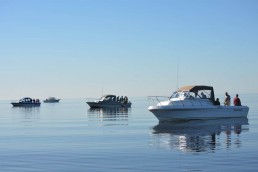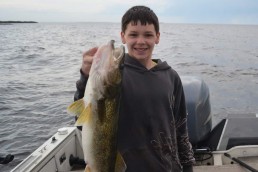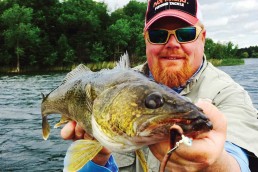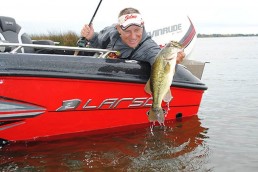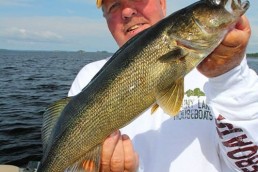Breaking Away from the Pack for Walleye Success
SHARE THIS POST
Whether you are an experienced guide or a novice angler, there can be merit in doing what everyone else is doing to catch walleyes, especially if they are catching them. A pack of boats in an area attracts attention, especially when the nets are swinging. When all of the fishing reports say jigging is the ticket, it’s good to take notice.
There are pros and cons to following the crowd. In many instances, breaking away from the pack, whether it is a different spot, a presentation others are not using or changing your speed will increase your success and further develop your confidence as an angler.
Strategy among a group of boats
Is fishing near a group of boats a bad thing? Absolutely not—as long as you are ethical and keep a respectable distance away. When there are literally thousands of walleyes in an area, it might make sense. In the big, open expanse of Big Traverse Bay on Lake of the Woods that goes for miles, there can often be a depth or an area that walleyes are keying in on, due to bait. Being close to this depth or area may be the ticket.
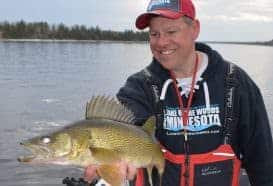
That doesn’t mean it’s necessary to set up in the middle of the boats. A nuance to fishing this same school of fish is to perhaps target the same depth, but purposefully set up away from the crowd. In many cases, a good number of boats can generate enough commotion to actually push some fish out, and being on the far fringes can be the best spot of all. The bait and fish sometimes move as the day goes on. This might present an opportunity to get in front of roaming walleyes that are headed deeper or shallower, or simply another direction.
Make a mental note as to what depth and bottom or structure the masses are targeting and use that info to set up strategically. Electronics can be helpful in determining where to set up. Marking baitfish and walleyes definitely is a piece of the puzzle and an advantage.
How about a milk run?
A “milk run” is a slang phrase referring to an angler trying a number of different spots until fish are found. Looking back at tournaments is when I realize just how effective milk runs have been. So many times we have pounded ourselves across big expanses of water to reach the promised land where we found walleyes the day or two before. In some cases, the weather, waves, wind and fish have changed. Often, we hammered those spots, picking away at the leftover fish until we have at least some in the livewell before moving on. In many cases we moved on and hit spots not even fished during pre-fishing that held better fish than our go-to spots.
During a milk run, we hit numerous spots quickly. Some spots are small, close to shore or don’t have a name on the map or chip. These are areas that don’t receive much attention. More often than not, these small areas hold fish. Not every spot may have walleyes, but that is the beauty of hitting a variety of spots quickly.
When checking these locations quickly, I prefer to pull a ‘crawler harness or a crankbait. If there is structure, my go-to is a crawler harness, as you can pull a 2-ounce bottom-bouncer with a harness and spinner in varied depths at about 1.25 mph without changing rigs. If I am in more of a flat area, crankbaits are hard to beat. Covering water, mixing up sizes, and using ones that wobble with colors are hard to beat.
Are you enjoying this post?
You can be among the first to get the latest info on where to go, what to use and how to use it!
Whether it’s Lake of the Woods or your favorite lake, zoom in on a GPS with a good chip installed sometime or look at a good map. Identify the “off-the-radar” areas that look good. Maybe it’s a small reef, a turn in the contour lines, a transition, from sand to mud or gravel to rock or maybe just an area of weeds. Many of these spots won’t attract packs of boats, but they will attract schools of walleyes.
A different presentation vs. the group can be a good thing
Have you ever heard the phrase, “It’s the little things that make a big difference?” It is especially true when walleye fishing.
Recently on LOW, I was jig fishing with my brother and we had anchored way off a huge pack of boats out on the mud flats. It was midmorning with a nice little chop on the water and literally nets were swinging everywhere. All of a sudden, the wind stopped. And 15 minutes later, so did the fish. It was like someone hit a switch in the wrong direction. After jigging for another 45 minutes without a bite, we switched up and pulled out our leadcore line-trolling gear. While almost every other boat in a pack spread out over a couple of miles continued to jig with very marginal success, we started to troll around the pack with crankbaits through thousands of fish we were marking. Although the fish didn’t jump into the boat, we finished up respectably during what turned out to be a tough part of the day. Our reward was some nice eaters as well as a handful of slot fish—changing tactics to pull crankbaits through thousands of fish made a difference.
During a recent MTT Tournament, my partner and I were pulling crawler harnesses on a reef among other boats. There was one boat clearly outfishing the group. After the tournament, I had a chance to chat with the anglers about their tactics. They were very open about how they had found a special, colored spinner blade during pre-fishing that matched the bait the walleyes were feeding on. Changing colors can make a difference with walleye success.
Breaking away from the pack may mean setting up on the very outskirts of a big pack of boats vs. among them, switching up colors, sizes or tactics or simply not fishing the same way everyone else is. In some cases, it’s a speed thing, showing the fish something faster or maybe slowing down might be the ticket.
On a river, maybe it’s slow-trolling into the current with your jig more horizontally behind the boat vs. anchoring up and vertical jigging or trolling cranks when the masses are jigging. There is usually some kind of twist that will make a positive difference.
As anglers, we are constantly working on becoming better at fishing. Breaking away from the pack often comes from confidence, which is a result of experience on the water. This summer, gain that experience on the water and break away from the pack.
MWO
SHARE THIS POST
Did you enjoy this post?
You can be among the first to get the latest info on where to go, what to use and how to use it!
Joe Henry
Tournament angler and licensed charter captain Joe Henry fishes and hunts the Midwest. Henry is a media member of AGLOW and writes for numerous publications, creates videos, appears on a variety of outdoor TV and radio shows and is a frequent seminar speaker. Henry is the Executive Director of Lake of the Woods Tourism.
